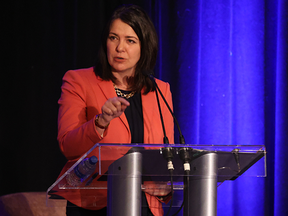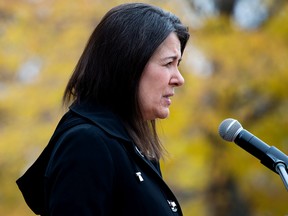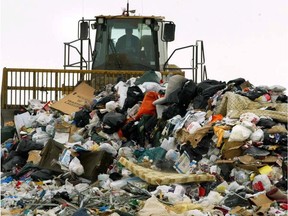Everyone who comes into public life carries baggage; Smith arrives with enough to fill the belly of a Westjet Dreamliner
Author of the article: Don Braid • Calgary Herald
Publishing date: Nov 24, 2022 •

Article content
Even Premier Danielle Smith might get a laugh out of this. Or these days, maybe not.
The comic genius Buck Henry did a Saturday Night Live skit as a radio “shock jock” way back in 1976.
Frank Noland, the host, sits before a bank of phones that aren’t ringing. Increasingly desperate, he throws out one outrageous subject after another.
When the phones stay silent, he wraps all his bait into one final frantic try: “Killing puppies — it doesn’t bother me. That’s me, Frank Noland, and I LIKE dead puppies!
“I’m totally in favour of using federally supported municipal bonds to pay for forced busing of Soviet communists to come into your homes to kill your puppies!
“Give me a call, won’t you? The lines are open.”
Nobody calls.
Smith, of course, had no trouble getting calls as a host of her radio talk show for six years.
That’s because, unlike Frank Noland, she was taken seriously by people who liked her libertarian viewpoint. She meant what she said. Just as important, she listened respectfully to what THEY said.
Smith rolled their ideas around, discussing them with real attention, whatever the deep-space distance from the mainstream. And she repeated her own firm views about health care, Ottawa and many other subjects countless times.
Everyone who comes into public life carries baggage. Smith arrives with enough to fill the belly of a WestJet Dreamliner.
Now she wants us to set all that aside. In her TV speech Tuesday, she said that in her media career she discussed hundreds of topics, and “sometimes took controversial positions, many of which have evolved or changed as I have grown and learned from listening to you.
“But I know I’m not a talk-show host or media commentator any longer. That is not my job today.” The job, she added, is “to serve each and every Albertan with everything I have.”
Smith had a chance, right there, to explicitly disavow some of her more incendiary plans.
But she can’t do that without seeming cynical or insincere for all those years. Her core supporters wouldn’t like it, and Smith herself might feel she would be dishonest.
And so, we did not hear her say no, we will not continue to press for private health-care insurance with co-pay and deductibles.
She did not say — as she has before — that her idea for Health Savings Accounts, now official policy, is a pathway to much more private payment for health care.
She did not change her view that masks should not only never be forced on people, but never recommended by her as premier in any situation.
And it wasn’t just radio talk. She formalized many of her beliefs in a long section of a paper for the U of C’s School of Public Policy.
It came out just after ex-premier Jason Kenney said he would resign, and before she declared she would run to replace him.
A lot of what she says makes sense, especially on provincial finances. But her cures for the problems, especially on health care, are often right off the deep end of public opinion.
I don’t believe the UCP can win an election with those views still in question. They’re a giant political piñata for the NDP to shred for months on end.
Smith wrote: “Once people get used to the concept of paying out of pocket for more things themselves, then we can change the conversation on health care.”
In her view, the system “has to shift the burden of payment away from taxpayers and toward private individuals, their employers and their insurance companies.
“If we establish the principle of Health Spending Accounts, then we can also establish co-payments.”
When the paper was released in June 2021, she did a video interview with veteran journalist Mario Toneguzzi for Business Insider.
RECOMMENDED FROM EDITORIAL

Braid: Smith pledges $2.4 billion of inflation relief in TV address to province

Braid: Smith's choices make her seem more moderate. But is she really changing?
She said it was a mistake to eliminate health-care premiums in 2008. (They brought about $1 billion annually into the health-care budget.)
“You don’t need any major surgery in a year, you don’t pay any portion toward the cost. You have a major surgery in a year, you pay a portion of the cost in a deductible, just like you would if you had a claim in your car insurance.”
Depending on income, she said, a person might pay no deductible, or $500 or $1,000.
Does she still want to do that? Will she be quiet about it for now, and then do it after she wins an election? Does she plan to push health-care costs to individuals and private insurance companies?
Smith needs to be specific about all of this. Otherwise, she will eventually get the Buck Henry treatment. Silence.
Don Braid’s column appears regularly in the Herald.
Twitter:@DonBraid
This premier was a professional talker for so long that we often know what she really wants, which can be quite different from what she now says
Author of the article: Don Braid • Calgary Herald
Publishing date: Nov 21, 2022 •
 Alberta Premier Danielle Smith speaks to the media outside Government House following the swearing-in of her new cabinet ministers, in Edmonton Monday, Oct. 24, 2022. PHOTO BY DAVID BLOOM /Postmedia
Alberta Premier Danielle Smith speaks to the media outside Government House following the swearing-in of her new cabinet ministers, in Edmonton Monday, Oct. 24, 2022. PHOTO BY DAVID BLOOM /PostmediaArticle content
Premier Danielle Smith stoked many fires in her media days. Now she’s trying to stomp one out with her apparent retreat on health spending accounts.
First, she said people would pay for their visits to family doctors with these accounts. The government would seed them with an initial $375 payment, presumably to everyone who holds an Alberta Health card.
But Smith went much further than that. She suggested the private accounts would eventually be the ONLY way family doctors would be paid.
“My view is that the entire budget for family practitioners should be paid for from Health Care Savings Accounts,” she said in June 2021, in a paper written for the University of Calgary’s School of Public Policy.
“If the government funded the account at $375 a year, that’s the equivalent of 10 trips to a GP, so there can be no argument that this would compromise access on the basis of ability to pay.”
Well, sorry, there is an argument. Many people need far more care in times of serious illness. The accounts would also discriminate against lower income people who lack the means to add their own funds to the account.
One GP calls the plan “short-sighted and knee-jerk, without due consideration of the vast array of concerns that a family doctor deals with.”
RECOMMENDED FROM EDITORIAL

Opinion: Danielle Smith's health care would help the rich and hurt everyday Albertans

Critics worry Danielle Smith's health care plan will lead to downloaded fees for Albertans

Details of Danielle Smith's $300 health account met with more criticism, questions
Smith suggested Albertans put their own money on top of the government’s $375, get their employers to pay in still more, and even fundraise for their personal accounts.
She threw out these ideas before anybody dreamed she’d be premier. But she still pushes the accounts in her mandate letter to Health Minister Jason Copping, ordering him to “work to establish Health Spending Accounts.”
The premier now says people could use their accounts only for services that aren’t covered by public health insurance — physiotherapy, medications, whatever.
 An excerpt from Premier Danielle Smith’s paper in the U of C School of Public Policy.
An excerpt from Premier Danielle Smith’s paper in the U of C School of Public Policy.There’s no more talk of physician visits being part of the plan. She blasts NDP Leader Rachel Notley twisting the truth, when Notley is pretty much pointing out what Smith herself has said.
This premier was a professional talker for so long that we often know what she really wants, which can be quite different from what she now says.
And the goal of these saving accounts is to groom the public for widespread private payment. That’s clear from her own words.
Smith said in the U of C paper: “Once people get used to the concept of paying out of pocket for more things themselves, then we can change the conversation on health care.”
She argued that the system “has to shift the burden of payment away from taxpayers and toward private individuals, their employers and their insurance companies.”
Even more startling, Smith calls for a “proper” overall health insurance system with deductibles or co-payment.
“If we establish the principle of Health Spending Accounts, then we can also establish co-payments,” she wrote.
“I can guarantee you as well that if the government creates this structure, business and non-profits will step up.
“Employers will make matching contributions to Health Spending Accounts. Non-profits will be established to make charitable contributions to the Health Spending Accounts of low-income earners so they can get a broader range of health services.
“Because that is the character of Albertans. We take care of each other. It’s what we do.”
In my experience, Albertans have always demanded a better system, but never one that makes them pay out of their own pockets.
Smith is toying with political explosives far more dangerous than former Premier Ralph Klein detonated in 2005, when he brought in the Third Way, a plan that would have allowed people to pay for upgraded surgeries and queue-jumping.
The uproar was so furious that Klein had to abandon the plan, but not before throwing a Liberal health policy paper at a teenage legislature page and shouting “I don’t need that crap!”
Smith’s wider plans would inevitably violate the Canada Health Act. A single public pay system is the very heart of the Act. Because Alberta conforms, Ottawa will deliver $5.3 billion to the province this year, 21.5 per cent of the health care budget.
Smith now says anything she does would comply with the federal law. But she constantly voices opposition to many federal policies and actions, claiming the right to nullify them.
It raises the question: would she use her looming Sovereignty Act for health care?
Don Braid’s column appears regularly in the Herald.
Twitter: @DonBraid














